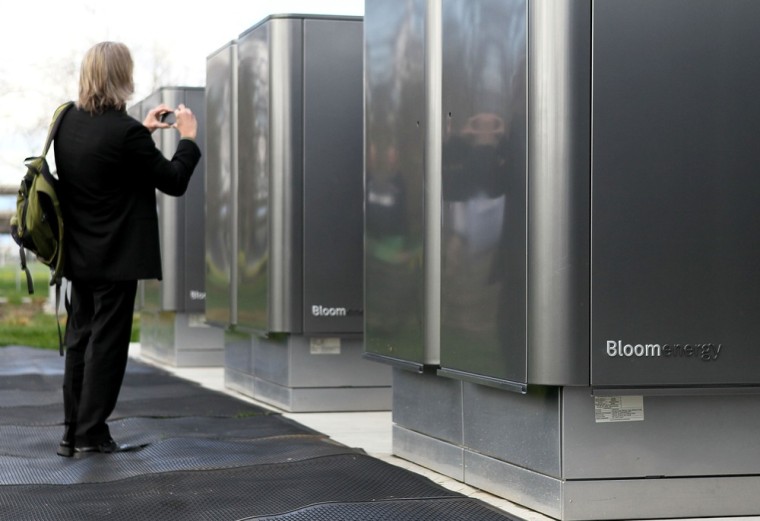An electricity-generating fuel-cell system known as the Bloom Box sparked a huge buzz in the energy debate six months ago — and since then, still more ventures have surfaced to promise better living through chemistry.
Will future fuel cells make good on those promises? We should know in the next couple of years.
One of the concepts, detailed on Monday at an American Chemical Society meeting in Boston, combines the environmental friendliness of solar power with the 24/7 capability of fuel-cell generation. When the sun shines, electricity from solar panels would feed into a personal power grid, and also split water into hydrogen and oxygen. When the sun isn't out, the hydrogen and oxygen can be recombined to keep the electricity flowing, producing pure water in the process.
"Our goal is to make each home its own power system," Daniel Nocera, a chemist at the Massachusetts Institute of Technology, explained in a . "We're working toward development of 'personalized' energy units that can be manufactured, distributed and installed inexpensively. There certainly are major obstacles to be overcome — existing fuel cells and solar cells must be improved, for instance. Nevertheless, one can envision villages in India and Africa not long from now purchasing an affordable basic system."
Electricity from waste water
Nocera and his colleagues started out with the water-splitting side of the equation. They found a more efficient way to convert H2O into hydrogen and oxygen, using relatively inexpensive catalysts that contain cobalt and nickel. And it doesn't need to be pure H2O. "Owing to the self-healing properties of the catalysts, these electrolyzers can use any water source," including seawater, waste water or water from the Charles River in Boston, the researchers say.
They contend that their system eliminates the need for expensive platinum catalysts — which would make the economics of fuel cells much more attractive. Prototype water-splitting systems have been built at a cost of $30 each, operating at power levels of 100 watts. The ACS news release says the catalytic system has been licensed to , an MIT commercial spin-off, and the venture aims to make super-efficient electrolyzers available for homes and small businesses within two years.
As Nocera noted, the big issues surrounding this system have to do with the costs for the other components: could cost tens of thousands of dollars, although government subsidies can . In order to get Nocera's make-it-yourself electricity system out to villages in the developing world, the devices to turn the hydrogen into energy would also have to become cheaper and more efficient.
Which fuel for fuel cells?
The Bloom Box is just one of the devices that has generated excitement among energy experts. It's generated electricity as well, in pilot projects at places ranging from to . Bloom Energy's 100-kilowatt "server" converts natural gas and air into electricity, producing water and carbon dioxide in the process (CH4+2O2 is turned into 2H2O+CO2).
There are still a couple of worrisome factors about that equation, however: First, the Bloom Box is powered by natural gas. The energy conversion factor (50 percent efficiency or better) compares with the best rates for gas-fired power plants, but it's still a fossil fuel. There are still carbon dioxide emissions as well, although the carbon footprint is not as great as it would be for a gas-fired plant.
Wyoming-based is working on a different approach: It's developing fuel cells that could take in biofuels — say, ethanol, methanol, butanol or even biodiesel that's converted to alcohol — and produce chemicals with industrial applications on the other side, along with the electricity.
"Our technology is the only existing technology that allows you to take a carbon-based fuel and make energy, and produce no CO2," the company's president and chief executive officer, Don Montgomery, told me during a recent sitdown.
The byproducts could range from acetic acid (which is used to make plastics and currently costs or more) to formic acid (a silage preservative that's ). Montgomery figures that the sale of chemicals produced by the NDCPower fuel cells, plus the no-CO2 angle, could win them some extra attention in the developing fuel-cell marketplace.
Ethanol plus Dran-O?
The key is in the chemicals used to make the fuel conversion — a recipe that Montgomery and his colleagues aren't talking publicly about, except in the broadest terms. "You basically take your ethanol and pour it into Dran-O," he joked. Dan Buttry, a chemistry professor at Arizona State University who also serves as NDCPower's chief technology officer, would say only that the secret ingredient is "not platinum."
Buttry also told me that the NDCPower fuel cell doesn't need a membrane — which is a plus, because in most fuel cells, the membrane "is a pretty big component of the cost."
Right now, NDCPower's main business is providing to the, um, U.S. military. But the company is aiming to make its mark in the civilian power market as well. And that market is just getting revved up. "The development curve has been like stepping on a rocket ship," Montgomery told me.
Fuel-cell technology isn't quite ready to reach orbit yet, and there are some big questions yet to be answered: Will the increased efficiency make up for the higher cost of fuel-cell devices? What's the right scale for fuel cells? Will we want to have a fuel cell in (or in , or every ), or does it make more sense to have big fuel-cell "servers" in office buildings or next-generation power plants? What'll it take to get to the vision of a "power plant in every home," as sketched out by MIT's Nocera. You can tell me (or tell me off) in Cosmic Log.
This report was initially published as a Cosmic Log item. Join the Cosmic Log corps by signing up as my or hooking up on .
